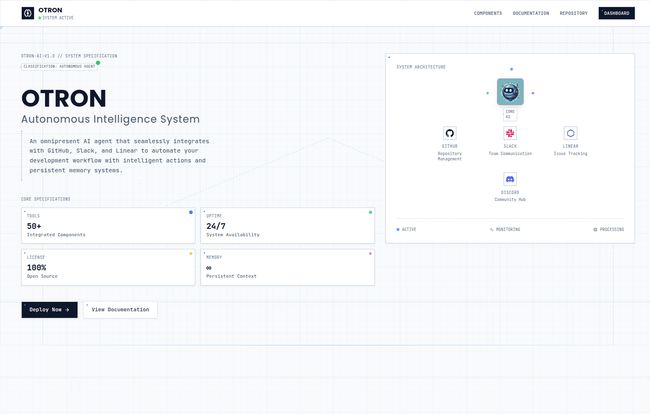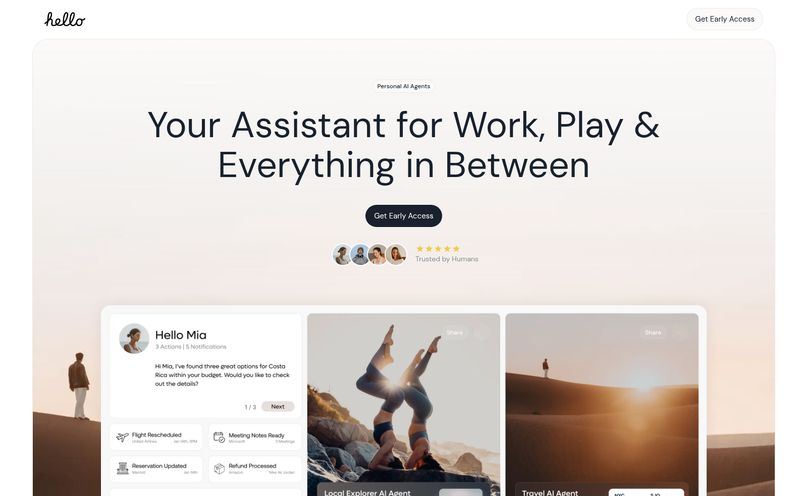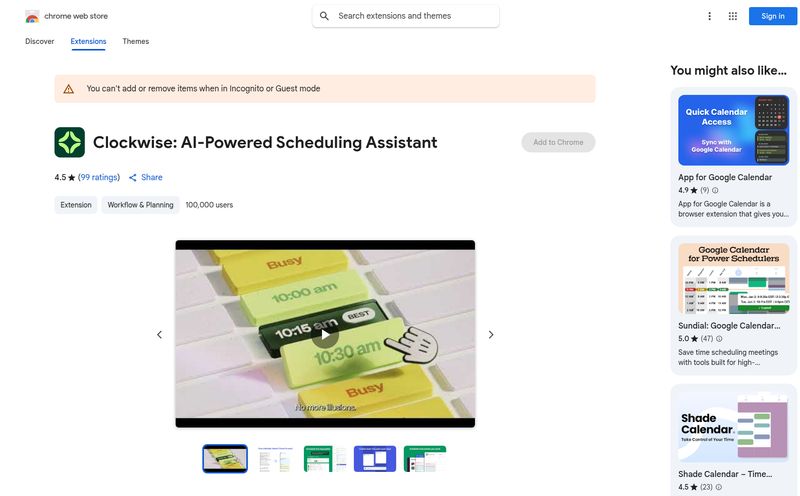The shared team inbox is where productivity goes to die. Whether it’s `support@`, `sales@`, or the dreaded `info@`, it’s a chaotic mess of duplicate replies, missed opportunities, and the constant, nagging question: “Did anyone get back to them?” For years, we've thrown more people at the problem or paid hefty monthly fees for complex helpdesks that feel like using a sledgehammer to crack a nut.
Every so often, a tool pops up that makes me lean in a little closer to my screen. Otron is one of those tools. It’s making some bold claims about being an “Autonomous Intelligence System” for your email, powered by AI and a visual workflow builder. But the part that really snagged my attention? A free email ticketing system with a pay-per-use model for its AI features.
That sounds... different. Almost too good to be true. So, as someone who has wrestled with more inboxes than I care to remember, I had to dig in and see if Otron is the real deal or just another piece of ambitious shelfware.
So, What is Otron, Really?
On the surface, Otron is an email-based ticketing solution designed for teams. You connect your shared inbox, and it turns that firehose of messages into a structured, manageable queue of tickets. Standard stuff, right? But that’s just the chassis. The engine is what they call “AI-driven workflows.”
Instead of just giving you a place to park your emails, Otron gives you the tools to automate what happens to them. Think of it less as a simple mailbox and more as an intelligent routing station for your customer communications. It’s built on the idea that many of the tasks we do manually—tagging emails, assigning them to the right person, finding customer history, even drafting initial replies—can and should be handled by a smart system. And you get to define the rules.

Visit Otron
The Core Features That Actually Matter
A feature list is just a feature list until you see how it applies to the daily grind. Here’s what stood out to me from an operations and traffic-generation perspective.
The Visual Workflow Builder: Your Automation Playground
This is the heart of Otron. If you’ve ever used tools like Zapier or Make.com, you’ll feel right at home. It’s a drag-and-drop interface where you can build logic flows for your incoming mail. “If an email contains the word ‘refund,’ then tag it as Urgent and assign it to the Finance team.” Or, “If a new email arrives from a known VIP client, prioritize it and send a notification to the account manager’s Slack.”
I’ve always felt that the best tools are the ones that give power to the people actually doing the work. You don’t need to be a developer to build these automations. That said, let’s be real: the information provided does hint at a “potential learning curve.” This isn't a one-click-and-you're-done solution. It’s more like a Lego Technic set than a Duplo block. It’s more powerful, you can build incredible things, but you’ll need to sit down and actually learn how the pieces fit together. For tinkerers like me, that’s a plus.
A Genuinely Free Ticketing System? Well, Almost.
This is a big one. Many powerful ticketing systems come with a hefty per-seat price tag that can be a real barrier for small businesses or startups. Otron’s core ticketing functionality is free. You can have your team in there, managing conversations, without that monthly subscription fee looming over your head.
The catch—and it’s a pretty fair one, in my opinion—is the AI. The clever, work-saving automations are what you pay for. It’s a classic “freemium” model, but instead of gating features behind a subscription, they’ve monetized the actions. It’s like a free-to-play game; you can run around the world for free, but if you want the magic sword or the speed boost, you drop a few coins. This can be incredibly cost-effective if your email volume is inconsistent.
The Smart AI Assistant
This isn’t just about sorting emails. Otron’s AI is designed to perform tasks. The website mentions over 90 AI-driven tasks, which could include things like:
- Sentiment Analysis: Automatically flagging emails from unhappy customers.
- Email Summarization: Giving you the gist of a long email thread without you having to read it all.
- Information Extraction: Pulling out key details like order numbers, names, or contact info and using them in other systems.
- Auto-Prioritization: Using context to decide which emails need a response now versus which can wait.
This is where the real time-saving magic happens. Getting this right means your team spends less time on administrative grunt work and more time actually helping customers or closing deals.
The All-Important Question on Otron's Pricing
Okay, so there isn’t a neat little pricing table on their site, which can be a red flag for some. But in the B2B SaaS world, especially for new, disruptive products, it's not that uncommon. The model here is pay-per-use. You pay for each AI action your workflows execute.
This is a double-edged sword, and you need to be aware of it.
On one hand, it’s brilliant. Have a slow month? You pay less. Just starting out and only need a few simple automations? Your bill will be tiny. It aligns your costs directly with your value. You’re not paying for idle software. For a startup watching every penny, this is a dream.
On the other hand, it can be unpredictable. If one of your blog posts goes viral and your inbox gets flooded with 10,000 emails, your automations will be firing on all cylinders—and so will your bill. The key is to be strategic. You need to build your workflows efficiently and maybe put caps or alerts in place. It demands a level of oversight that a flat-rate subscription doesn’t.
The Good, The Bad, and The AI-Reliant
So, let's break it down. No tool is perfect, and Otron is no exception.
What I love is the democratization of powerful tools. The free entry point is massive. It lets any team, regardless of budget, get a proper ticketing system. The visual workflow builder is empowering, and the pay-per-use model can genuinely save a lot of money for the right kind of business. It feels modern and fair.
However, that learning curve for the workflow builder is a real consideration. This isn’t for the completely tech-averse. And while the pay-per-use model is great for cost-conscious teams, the potential for a surprise bill is a valid concern. My biggest hesitation is always the reliance on AI. You're handing over a part of your customer interaction to an algorithm. That requires trust and, more importantly, verification. You need to be sure the AI is doing what you think it's doing, which means ongoing monitoring.
Who Should Give Otron a Shot? (And Who Should Pass?)
Based on my analysis, Otron isn't a one-size-fits-all solution. It's built for a specific kind of user.
I'd say it's a perfect fit for:
- Startups and SMBs: Teams that need a professional system to manage support or sales inquiries but can't stomach a $50/user/month price tag.
- Marketing and Operations Teams: People who love to optimize and automate. If you get a thrill from building a clever Zap, you will probably love building Otron workflows.
- Businesses with Repetitive Inquiries: Companies that get a lot of the same questions over and over are prime candidates for AI-powered automation.
On the flip side, you might want to steer clear if you are:
- A Large Enterprise: Big companies often need predictable, fixed budgets, ironclad SLAs, and dedicated account managers, which might not be Otron’s focus right now.
- A Completely Non-Technical Team: If the idea of a drag-and-drop builder sounds intimidating, the initial setup could be a frustrating experience.
My Final Take on Otron
After looking at what Otron offers, I'm genuinely intrigued. It’s not just another helpdesk clone. It’s a tool built on a modern philosophy: give users the power to build their own solutions and charge them fairly for the resources they consume. It won't replace Zendesk for a Fortune 500 company tomorrow, but it could absolutely revolutionize how a growing ecommerce store or a SaaS startup handles its customer communications.
It’s a tool for builders, for optimizers, for the teams that want to punch above their weight. It trades the simplicity of a fixed, out-of-the-box system for the power of customization and cost control. And in my book, that’s a trade worth considering.
Frequently Asked Questions about Otron
- Is Otron really free?
- The core email ticketing system for your team is free. You only pay for the AI-powered actions that you configure in your workflows, like automatic tagging, summarization, or routing.
- Do I need to be a developer to use Otron's automations?
- No, you don't need to write code. Otron uses a visual, drag-and-drop workflow builder. However, there is a learning curve, and it helps to have a logical mindset for setting up the rules effectively.
- How does the pay-per-use AI model work?
- You are charged a small amount for each specific AI task that is completed. For example, every time the AI successfully summarizes an email or extracts an order number, that would count as a single, billable action. Pricing is granular, so you control your spending through the workflows you build.
- Is Otron a good alternative to platforms like Zendesk or Intercom?
- It can be, especially for small to medium-sized businesses. If your main goal is powerful email automation and cost control, Otron is a very strong contender. If you need a comprehensive suite with live chat, a knowledge base, and phone support all in one, a more established platform might be a better fit for now.
- Can I control the AI in Otron?
- Yes. The platform's emphasis on "deterministic processes" suggests that you are in full control. You build the specific rules and logic that the AI follows. The AI doesn't go rogue; it only executes the tasks you've defined within your visual workflows.
- What happens if my email volume suddenly spikes?
- Your AI usage, and therefore your costs, will also spike. This model requires you to be mindful of your workflows. It's a good idea to monitor your usage, especially after any marketing campaign or event that might increase inbound email.
Conclusion
Otron is a fascinating take on a problem that plagues so many businesses. It’s not trying to be just another inbox. It’s trying to be a smarter one. By combining a free, solid ticketing foundation with a flexible and powerful AI automation layer, it puts control back in the hands of the user. It won’t be for everyone, and it demands a bit more thought than a simple plug-and-play solution. But for teams ready to roll up their sleeves and build a smarter, more efficient communication engine, Otron is definitely one to watch. It might just be the breath of fresh air your team inbox needs.
Reference and Sources
- Otron Official Website (Note: This is an assumed URL based on the branding)
- The Rise of No-Code and Low-Code Platforms - TechCrunch article discussing the trend Otron leverages.
- The Future Of SaaS Is Usage-Based Pricing - A Forbes piece on the shift towards pay-per-use models.



